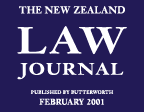
Book Review, New Zealand Law Journal, February 2001
Julia Pedley, Massey University
reviews the Encyclopedia of Real Estate Terms, (2nd ed) by Damien Abbott, Delta Alpha Publishing.
Anyone who has an involvement in real estate will find this book an invaluable reference resource. Published some 14 years after the publication of the first edition, the book (which has been completely rewritten and enlarged), draws on material from the North American, United Kingdom, French, Canadian, Irish, Australian and New Zealand jurisdictions. The book claims to be "a comprehensive reference book on real estate – a dictionary, a thesaurus and an Encyclopedia rolled into one". (preface vii.) Entries are current as at the end of 1999*. Following the preface and acknowledgements, the 1.472 page book, commences with a User's Guide and an alphabetical list of References and Abbreviations. These are followed by the main substance of this single-volume text, 1,289 pages, an A-Z Text of Entries, where the author guides the reader through a meticulously researched explanation of over 8000 words and phrases used in connection with real property. These terms are based on American and English practice, as well as terms from the civil law, French and Scots law and the Commonwealth. Familiar terms such as "fee simple", "mortgagor", and "landlord and tenant" abound, as well as obscure ones such as "common of pannage", "bedroom community", "white rent" and "widow's quarantine". Within these pages the reader can discover what a "white bonnet", a "puffer", a "capper" and a "decoy duck" all have in common. The aim of the Encyclopedia "is to help the user understand the meaning of a particular term and its many facets; to appreciate its practical significance in practice; and to provide a ready means for further reference and specialist research" (User's Guide xv.) This has been achieved by the author in that for each of the alphabetised entries, the word or phrase is generally followed by a clear and authoritative definition containing references to cases (in many instances with the quotations from the case selected), statutory references, cross-references and bibliographic references. The author, a specialist in real estate, has extensive experience in real estate development, investment, management and finance. Hence the book is not only a comprehensive reference on real estate terminology, but also extends to in-depth coverage of related terms on aspects of contract law, tort, finance, insurance and investment. This gives insight into the interrelationship between real estate and other associated disciplines. What makes the book special is both its sheer breadth of coverage which makes for wide and fascinating reading, and the clarity of exposition in which the terms are defined and explained. The scope of the work is astonishing and boasts some impressive statistics, containing more than 11,000 references (including 3,900 cases, 2,000 statutory or code references, |
and 4,750 bibliographical references – the majority of which are referenced directly by page or paragraph number). In addition, a cross-referencing system which extends to more than 30,000 entries results in a remarkable extensive and thorough reference work. Here, the reader will encounter a vast array of real property terms at both the macro and micro level covering every aspect of real estate (appraisal, law, management, economics, finance, insurance, investment, taxation, and urban planning). For a book of this depth and volume the contents are presented in an easy accessible style. Words or phrases appear in the text of entries in boldface type in a word-by-word order. Cross-references are in boldface type. The extensive use of cross-referencing is an important feature of this outstanding work, in that it ensures the reader is directed to refer to other matter of related significance. Case citations are clearly identified and are sourced from a wide variety of jurisdictions. The inclusion of bibliographical references will appeal to those seeking a comparative analysis and sources for further research. All of this guarantees the book is straightforward to use with words or phrases able to be quickly located and cross-referencing followed up on. |
*Publisher's note: updated by Third Edition and Real Estate Defined Online
